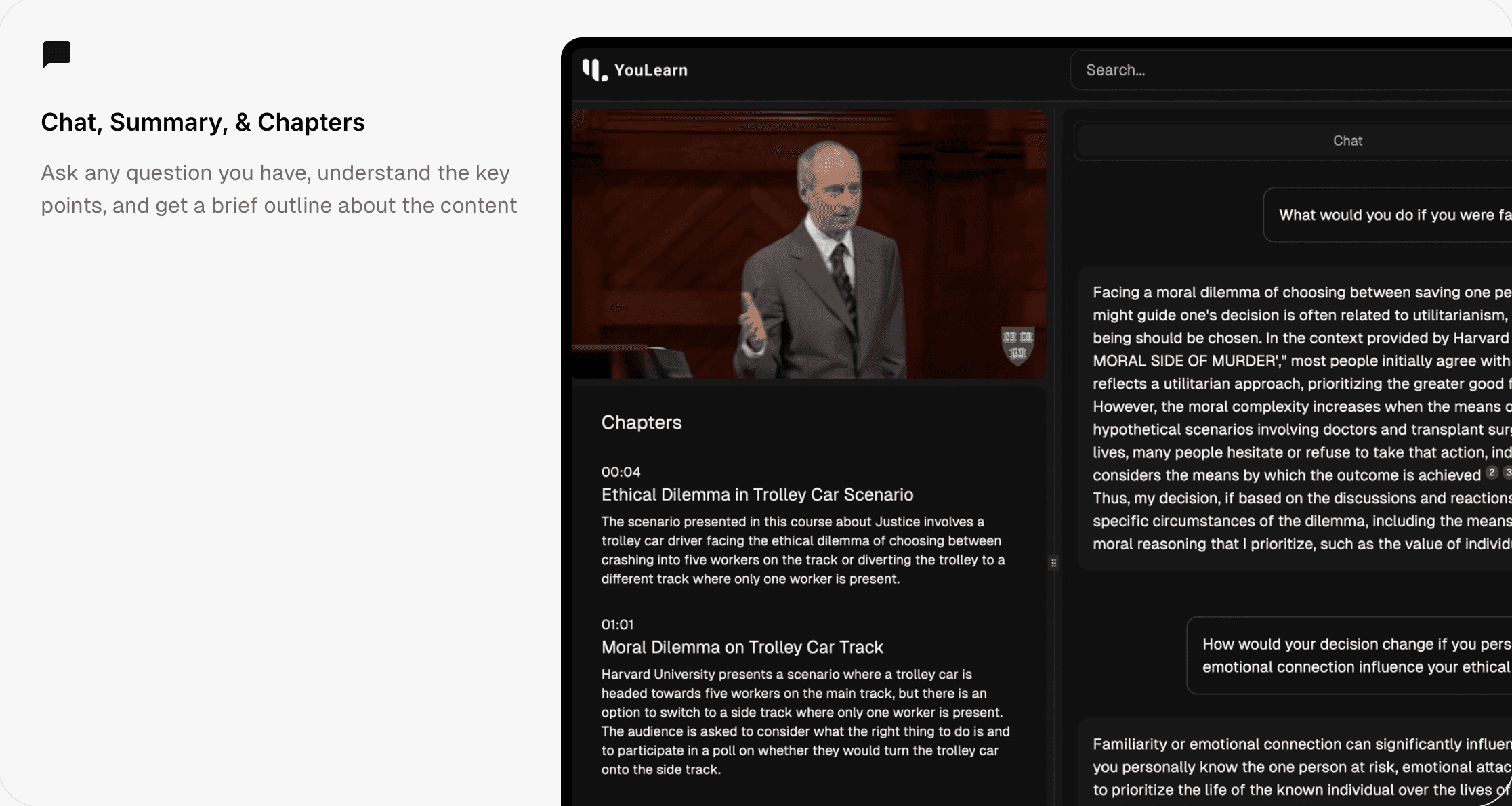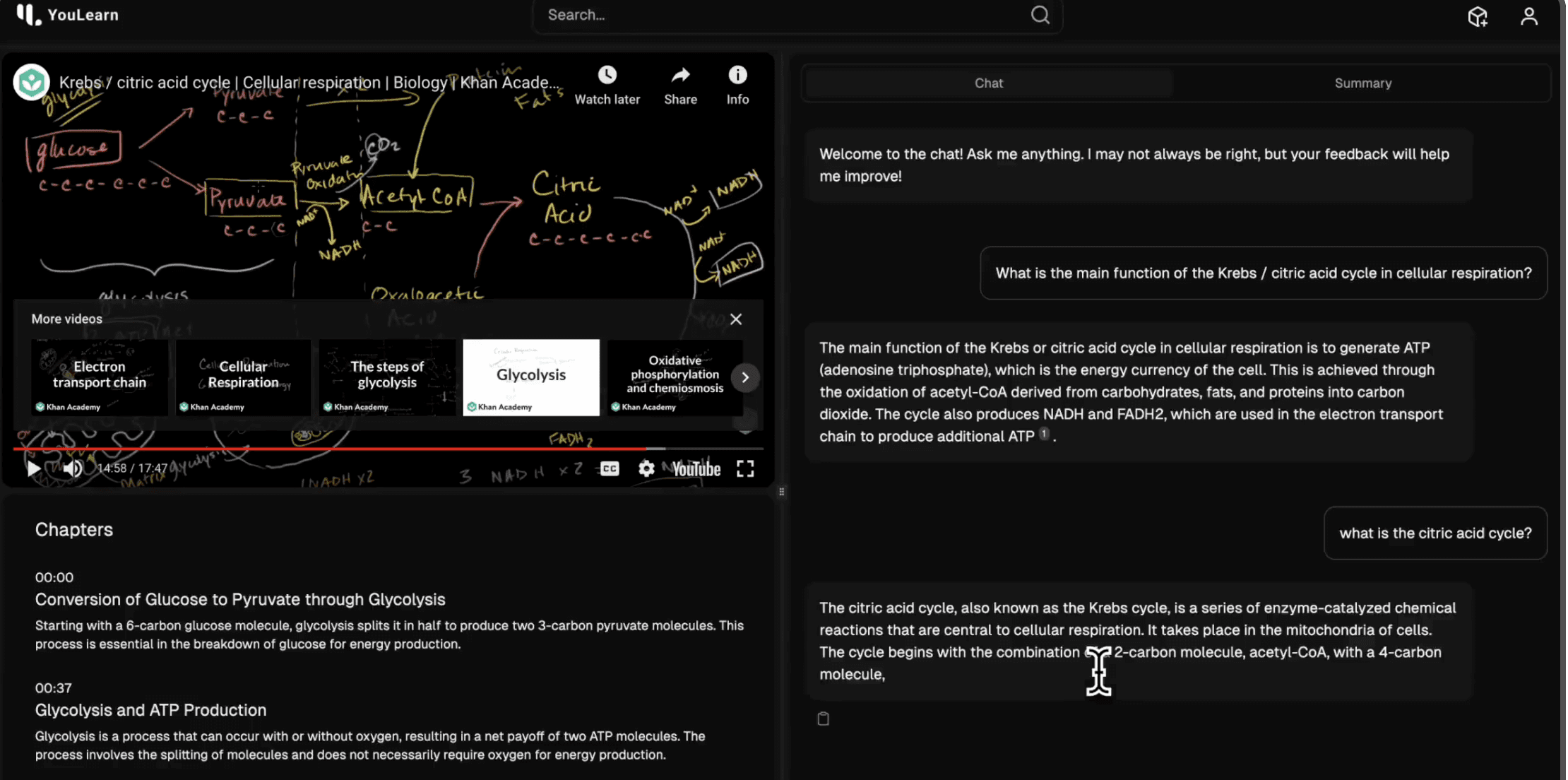7 Best Active Study Methods That Actually Work
Sep 26, 2024

YouLearn Team
Reading and rereading your study materials is boring. Even worse, it doesn’t help you learn any better. You're not alone if you find yourself in a study rut like this one. Students face many challenges when it comes to studying effectively. Worse, the longer you use ineffective study techniques, the more they can hurt your grades and self-esteem.
Active study methods can help you break free from your study rut. In this guide, we’ll explore the benefits of these techniques for learning and retention and how to be a better student. You’ll also learn how AI tools like YouLearn’s personal AI tutor can help you reach your academic goals.
Table of Contents
What Is An Active Study Method?

Active study methods engage students in learning through cognitive interaction with the material. Cognitive science research has shown that these active study methods are far superior to traditional passive study methods.
Passive studying, for example, might involve reading a textbook chapter or listening to a recorded lecture. Active studying, by contrast, engages the student in the content of the chapter or lecture by promoting discussion, analysis, synthesis, problem-solving, reflection, questioning, and practice.
Excellent Strategies for Active Studying
Active studying can take many forms. Here are some examples:
Explain the material in your own words and speak it aloud.
After reading a textbook section or hearing a lecture on a topic, summarize the material in your own words. Doing this out loud rather than just on paper helps reinforce your learning.
Formulate and write down questions as you read.
Be curious. What do you want to know about the material? What is unclear? Write down questions as you read, and then look for the answers.
Answer practice questions and seek to do additional practice questions/problems.
If you can find practice questions or issues related to your course material, do them. They will help you understand the material better and prepare you for exams.
Relate theories to real-life examples, interests, or stories
Connect your course material and your life or things that interest you. This will make the information more meaningful and memorable.
Develop a concept map or flowchart to organize material
Visual aids can help you better understand and remember course material. Breaking down complex information into smaller, more manageable parts can reduce anxiety and improve recall.
Break diagrams down into smaller parts to explain how each part of the process works together
If you encounter a diagram in your studies, don’t just memorize it. Instead, explain how the various parts of the diagram relate to one another.
Participate in group discussions and group study sessions
Group work can enhance learning, especially for students benefitting from social interaction. Studying with peers allows you to gain different perspectives on the material and reinforce your understanding by explaining concepts to others.
Related Reading
• How to Pass a Test
• How to Be a Good Student
• Back to School Tips
Benefits of Active Study Methods

1. Active Study Methods Foster Higher Engagement
Active study methods enhance learner engagement. With active study, learners transition from passive information observers to actively engaging with the material. Learners directly involved with their assessments develop a positive relationship with their training. Active learning helps them gain a deeper understanding of the material, which leads to improved learning success.
2. Active Study Methods Improve Collaboration Skills
Active study methods improve collaboration skills. Instead of simply listening to instructor-led training, this type of learning leverages the power of collaboration and social interaction to learn and solve problems. Through interactive activities, learners improve their collaboration skills to make teamwork successful.
3. Active Study Methods Build Self-Confidence
Active study methods build self-confidence. Active learning creates an environment where learners are pulled out of their comfort zones. They are expected to share their thoughts, opinions, and conclusions about specific topics rather than simply bombard and spoon-feed them with knowledge until the training ends. As they become more comfortable speaking up, learners will gain greater freedom from self-doubt and build self-confidence.
4. Active Study Methods Promote Higher Learning Retention
Active study methods promote higher learning retention. Active learning is scientifically proven to result in insignificantly increased message retention. An active learner definition based on Dale’s Cone of Experience reveals that learners take in more information through “action-learning” because of its direct and purposeful nature. Since learners can participate and actively do things, they retain at least 90% of the learning materials.
5. Active Study Methods Make Learning More Fun and Exciting
Active study methods make learning more fun and exciting. Nothing is more boring than sitting and listening in a training or seminar until the talking ends. Lack of interaction leads to a poor personalized learning experience, which leads to an absolute waste of time, energy, and money. Your ultimate lifesaver? — shifting to active learning.
6. Active Study Methods Increase Learners’ Motivation to Learn
Active study methods increase learners’ motivation to learn. It’s easy to tune out in class if participation is not technically needed—traditional passive learning is, unfortunately, more like this. However, in an active learning environment, no one is invisible. This sort of learning necessitates everyone’s presence and cooperation for a fruitful discussion. In return, learners are urged to prepare ahead of time and ensure they are ready to respond and participate in their training sessions.
7. Active Study Methods Stretch Creativity and Innovation
Active study methods stretch creativity and innovation. Stemming from its need for everyone’s engagement and collaboration, active learning pushes learners to use their imagination and further expand their creativity to contribute in class. Active learning also helps widen their perspectives by bouncing off one another’s opinions as they work in groups.
8. Active Study Methods Improve Critical Thinking and Problem-Solving Skills
Active study methods improve critical thinking and problem-solving skills. Active learning activities like question-and-answer sessions and debates encourage learners to think outside the box and take their critical thinking to the next level. They will help reinforce conceptual knowledge among learners, and these activities will also develop and nurture their problem-solving and decision-making abilities.
9. Active Study Methods Allow Instant Feedback and Improvement
Active study methods allow instant feedback and improvement. Active learning typically entails hands-on activities, quizzes, and assessments that will enable instructors to immediately evaluate their learners’ understanding of their training topics. This allows them to provide their learners with instant feedback and guidance to overcome performance gaps and achieve their desired learning goals.
10. Active Study Methods Increase Training Success
Active study methods increase training success. Even if you’ve invested in the most expensive edtech training tools and learning materials, your training will fail if your learners aren’t fully involved, engaged, and motivated. Adopting an active learning method, on the other hand, helps overcome all of these barriers to training success. Active learners work harder to achieve success and produce better results since they actively participate in their learning environments.
Active Studying vs Passive Studying
Active and passive studying are two very different approaches to learning. The differences between these two learning styles center primarily on who works to achieve the learning. A classroom teacher should not have to work overtime to ensure students are learning content. Teaching and learning should have some balance. Active learning is learner-centered, and passive learning is teacher-centered.
Active learning requires students to think, discuss, challenge, and analyze information. Passive learning requires learners to absorb, assimilate, consider, and translate information. Active learning encourages conversation and debate, while passive learning encourages active listening and paying attention to detail. Traditionally, active learning is considered to activate higher-order thinking, while passive learning helps students retain information.
Active Studying Will Help You Challenge Your Ideas
Active studying will allow students to challenge preconceived notions and biases during discussions and defend their beliefs. Students have to have vital observation, communication, and critical thinking skills. On the other hand, with passive learning, students can consider their beliefs. As a listener, they may not always get the opportunity to confront an idea, but they can still recognize the difference between what they believe and what is presented.
Passive Studying Can Help You Sort Your Ideas
Learners in a passive setting are only sometimes encouraged to challenge ideas, which may only sometimes be necessary when learning skills in certain mathematical or scientific subjects where the facts are firm. However, in whichever learning environment, a good teacher will encourage a strong learner to ask questions when confused and ensure the clarification of all learning.
7 Best Active Study Methods That Actually Work

1. Turbocharge Your Learning with YouLearn AI
Imagine having a personal tutor available 24/7 to help you study. YouLearn is an AI-powered studying tool that can assist you with learning from YouTube videos, PDFs, and slides. Just upload your content, and our AI chats about it, provide quick summaries, break information into digestible chapters, and transforms your material into an interactive learning experience. With YouLearn, you'll grasp material quicker and more effectively to learn more intelligently, not harder.

2. The Feynman Technique: Study Smarter by Teaching it to a Child
Have you ever sat in class with a teacher who explained a complex topic, leaving you having learned almost nothing? You’re not alone. Nobel Prize-winning physicist Richard Feynman evolved an active study technique for teaching and communication in the late 20th century based on learning via concise thoughts and simple language.
Called the ‘Feynman Technique,’ this process is one of the most popular self-learning techniques. It helps you overcome some of the most commonly reported problems during learning: not understanding the concept in detail, quickly forgetting what you have learned, and failing to learn details. Essentially, the technique is a quick and targeted learning method to help you learn new concepts, cover knowledge gaps, and revise ideas you don’t want to forget.
One of the most defining features of the Feynman Technique is that it bases itself on the premise that “if you can teach it to a child, you’re way ahead of the game.” Why? For two central reasons: a) speaking in plain terms forces you to explain everything in detail, and b) the attention span of a child is short - you’ll learn how to recite all necessary information quickly and succinctly - capturing the most critical details in your long-term memory. How does it work? You can apply the Feynman Technique to your studying in just four simple steps:
1. Identify the subject
Before picking up a textbook, refresh your understanding by writing down everything you already know from memory.
2. Teach it to a child
Start with a fresh paper and write down everything you know in plain English - as if a child could understand everything you’re talking about.
3. Review knowledge gaps
Read the textbook or learning materials and add any information you missed to your notes.
4. Organize and simplify
Spellcheck, color-code, and organize notes in a straightforward yet concise way. Add images and diagrams where possible to stimulate your visual memory.
When you come to sit down and revise that topic, you’ll already have a condensed set of notes with which you can start. From there, you can continue to build on your existing knowledge, adding more notes and ideas as you ‘re-teach’ the topic.
So, the next time you find yourself sitting down to an empty notebook page, think about how you can turn that page into an opportunity to test what you already know and evolve new ideas—helping you to continue a part of ongoing learning critical to the fundamentals of deep, meaningful work.
3. The Leitner System: Use Flashcards to Study Smarter, Not Harder
Are you someone who always turns to flashcards during revision season? How do you know you’re using them in the most effective way possible? Let us introduce you to the Leitner System. The Leitner System is an active learning technique designed to help you retain more information in the long term. Tailored towards students who are already familiar with content and are revising for an assessment, it uses flashcards to help you learn fast, memorize more, and get into the routine of revising material at regular intervals.
So, how does it work? First and foremost, the Leitner System relies on flashcards. So, if you haven’t yet started condensing my notes into this format, you must do so before trying to attempt this active study technique. You then need to set me up with five separate boxes to store my cards in—we recommend labeling 1-5 of them to keep track of my progress.
As a process, the Leitner System is quite simple. Every card begins in Box 1. If you test yourself on that card and discover you get it right, move it along into Box 2 or the next one (if I am already at Box 2). If you get the card wrong, move it down a box or keep it in Box 1 (if it’s already there). Each box determines how much you will study each set of cards based on how well I already know the content:
Box 1
Every day
Box 2
Every 2 days
Box 3
Every 4 days
Box 4
Every 9 days
Box 5
Every 14 days
Then, you incorporate the ‘boxes’ into your study schedule, remembering to test each box within the recommended daily time bracket. It’s important to note that these time frames are just a rough guideline, and you can move my study schedule at a pace that may be more suitable for you - just practice a few different lengths and see which one works best at helping you to retain the most amount of information.
Regularly testing your knowledge and using active recall can help you memorize more content over an extended period, ultimately improving your long-term memory. By the end of your revision period, you should have most of my cards in box 5, meaning you can retain information for extended periods without prompting.
4. SQ3R: A Method to Help You Read and Retain Information Actively
How often do you find yourself reading through pages of textbook information only to remember almost nothing? Too often, students find themselves absent-mindedly scanning pages of text, with the ability to recall very little to nearly none of the information they have read. However, the SQ3R method can help those who struggle with this.
Evolved from a prominent American psychologist, Francis P. Robinson, in the 1940s, the active study technique is designed to enhance the learning process involved with reading material, which is often a passive process.
SQ3R is an acronym for Survey, Question, Read, Recite, and Review - which refers to the steps involved in actively reading, understanding, and memorizing a text. Through this sequence, you’ll engage with your reading before, during, and after the process - leading to increased understanding of the text. Let’s take a deeper look at what the process involves:
Survey
You should review your text to gain an initial understanding of its topic. To do this, quickly skim through and look for headings, bolded text, charts, and diagrams.
Question
After reading this initial preview, start generating questions about what you want to learn from the content of the text. For example, can you convert any headings into questions? If there aren’t any, can you convert these into more general questions such as “what is page 14 about?”
Read
As you read through the text again, do so actively, considering the background work I’ve done in the previous steps. The questions I’ve written down should help me focus my reading.
Recite (also called Recall)
As you move through the text, recite or rehearse information for each question using your own words. This can be done in spoken or written form—as long as I formulate the text's content, it doesn’t matter.
Review
Once you have finished reading my section of the text, review the content by repeating the main ideas and any essential terms and definitions.
By following the process in this way, you’ll be able to anticipate what you can expect to learn, have a clear direction for your attention while reading, and take the time to review what you have learned—helping you retain information in the long term.
5. The Pause Procedure: A Simple Method to Help You Study Actively
The ' Pause Procedure ' is another simple yet relatively effective active study technique. As the name suggests, the concept works by adding regular ‘pauses’ or ‘breaks’ into your learning so you can refocus and recite everything you’ve learned.
By placing interspersed, strategic pauses in your learning, you’ll have an opportunity to review the information you’ve learned so far, fill in any knowledge gaps, and recite the content into your long-term memory. Recent research has found that this study technique is effective at increasing student attention and learning outcomes, helping students “review their notes, reflect on them, discuss and explain the key ideas.”
To use the pause procedure yourself, arrange for pauses of two to five minutes between every 15 minutes of study time. During these breaks, take the opportunity to review what I’ve learned using one of the following methods:
Rework and organize my notes
Write a list of questions I still need information about
Discuss the topic with a study buddy (if working with another student)
Answer end-of-chapter questions
Write a paragraph about the key ideas from my study session
This method is effective as it adopts some elements of the widely used Pomodoro technique—which encourages you to work in short study stints to maintain focus—while enabling you to use your break time to review what you have learned and guide the focus for your next study session.
6. Active Retrieval Quizzing: Why Testing is a Good Thing
Now, when you hear the word ‘exam’ or ‘quiz,’ it can be easy to shudder at the thought of putting my subject knowledge to the test and assessing how much I do (or don’t) know. Unsurprisingly, tests and exams are usually considered assessment devices in educational settings and can fill even the most confident and able students with dread.
However, the very act of self-quizzing or answering questions after studying a particular topic can be a positive act for students, helping them to identify any knowledge gaps and focus on where to direct later study. This is because quizzes are a form of the active retrieval process, allowing you to recall the information you have learned and manipulate it to answer the question in front of you. As a study method, active retrieval has been found to help improve the long-term retention of information for students and is often a popular study method used by those revising for exams.
Taking a memory test assesses my understanding of information and enhances my memory retention - a phenomenon known as the ‘testing effect.’ As you read through my textbooks or finish a lesson, try self-quizzing myself to see whether I have understood the content I have just learned. I can do so by finding questions at the end of each textbook chapter, looking at past papers online, or simply making up questions that may be asked or used in a formal examination.
7. Chunking Information: A Method to Help You Organize Content for Study
When revising, many students find condensing their content into flashcards effective at helping them memorize and recall lots of information, with only a small prompt or question to activate their thinking. So, when tackling new content in the classroom or when studying online, why not implement this process from the beginning and reduce the amount of notes and information I need to produce and sift through later?
Taking my notes and ‘chunking’ them into a less word-dominant format can be an effective way to take a lot of information and condense it into one or two pages of words, symbols, numbers, and/or diagrams that prompt me to think about and retrieve further detail about the topic rather than turning to streams of pages of notes.
To do this most effectively, we recommend taking a chapter of text at a time - or a lecture - and summarizing it into a page of short symbols, words, or diagrams that jog my memory into recalling what that section of content was about. You can chunk information in the following ways:
Summarise notes into a storyboard
Drawing diagrams to represent processes
Condensing long processes into short, numbered lists
Create charts to display data
Draw lines between related content (like a mind map)
Visual stimulants, in particular, are very effective when used with text. Much research has been conducted into the relationship between symbols, words, and pictures and memory retention - with a striking correlation found between memory retention and those who use images while studying. So, wherever possible, combine words, photographs, and other diagrams to summarize your notes - rather than just condensing pages of writing into fewer pages of text.
How Effective Is Active Studying

Active study methods (a.k.a. active learning or student-centered learning) involve students doing things to learn rather than passively listening to a teacher. When students use active study techniques, they engage with the material, which helps them retain information better. Examples of active study techniques include making flashcards, creating study guides, drawing diagrams, teaching concepts to a friend, and more. Active study often contrasts with traditional methods involving reading a textbook or listening to a lecture.
A meta-analysis of 225 studies comparing active learning versus lecture-centered course designs in STEM (Science, Technology, Engineering, and Math) disciplines found that students in traditional lectures were 1.5 times more likely to fail than students in courses with active learning (Freeman et al., 2014). Moreover, Freeman and colleagues found that student performance on exams, concept inventories, and other assessments increased by about half a standard deviation when some active learning was included in the course design. These results were found across STEM disciplines.
How Can I Focus 100% On Studying

1. Craft a Detailed Schedule
You should already have a solid idea about when your assignments are due. Create a study schedule right now to help you get ahead. Even if you don’t know the exact date of each exam, you likely know the week(s) they’re scheduled for. Map out a plan for how you’ll tackle your work.
Whether reading, researching, writing, or revising, give yourself a target to achieve at the end of each week so you know you’re on track to have everything ready in time for the deadlines. Investing in a wall calendar or diary is a good idea as you can mark important dates. It will help you see how much time you have left and when you will work on what.
2. Establish a Calm Study Space
If you plan on studying from home, tidy your room and clear your desk of clutter. As they say, clean space makes way for a clear mind – which you need when studying. You’ll also find it easier to focus if your study space is somewhere you enjoy being. A potted plant and decent lighting are small steps to creating your ultimate study haven. Calm music and scented reed diffusers can help relax your senses, putting you in a reasonable frame of mind to get some work done.
3. Remember to Take Breaks
Studies repeatedly show that productivity increases when students take regular breaks. By breaking down your revision or essay writing into manageable chunks, you’re more likely to remain focused and keep your brain engaged on the subject at hand. For every 45 minutes of solid work you do, take a 15-minute break away from your desk. Whether it’s popping outside for fresh air, having a quick tidy, or doing some stretches, we guarantee your brain will thank you later!
4. Don’t Let Social Media Distract You
Nowadays, it’s almost too easy to be distracted by social media. When your phone buzzes in your pocket, it’s impossible to ignore the alluring call of a Snapchat or Instagram notification. And before you know it, you’ve spent the afternoon scrolling through cute animal pictures and funny videos, and no work has been done. But fear not; software developers have found a way to help students during times when they need to focus.
You can download browser extensions such as ‘StayFocusd,’ which blocks your most distracting websites for a set amount of time. Smartphone users can install apps such as ‘Offtime,’ which allow you to filter modes such as Work or Friends so you can access only the things you need and won’t be distracted by any unnecessary gaming or social media apps.
5. Eat Healthy and Stay Hydrated
During exam periods, it’s often the case that students become so focused on their work that they forget to focus on their well-being. The easiest way to help yourself perform to the best of your ability is to stay hydrated and avoid junk food. Set a reminder on your phone to drink a large glass of water every couple of hours and snack on healthy fruit and nuts during your studies. A lack of water or eating foods with high levels of fat will make you feel irritable and lethargic, which is the last thing you’ll want when trying to be productive!
6. Reward Yourself for Your Hard Work
Rewarding yourself for studying is critical to staying motivated. These can be small rewards, such as a square of chocolate for each paragraph you write or watching an episode of your favorite Netflix series when you’ve mastered revising a specific topic. When you feel you’ve been working hard or assignments have been handed in and exams finished, reward yourself with more significant things, such as a night out with friends or buying those boots you’ve had your eye on for months. Remember, because it’s exam season doesn’t mean you shouldn’t enjoy yourself.
7. Avoid Pulling All-Nighters
You may think that staying up all night working keeps you on track with your studies. But doing all-nighters and functioning without sleep can severely impact your health and, in turn, impede your work. A good night’s sleep is vital to help you stay focused and learn efficiently. Sleep helps consolidate memory, which is essential when studying and converting short-term to long-term memory. So, swap the extra cups of coffee or cans of Red Bull for your bed and get the hours of sleep you need every night.
Learn Anything With Ease for Free Today with YouLearn's

YouLearn is your AI tutor, designed to supercharge your learning from YouTube videos, PDFs, and slides. Our AI chats with you about the content provides quick summaries, and breaks information into digestible chapters.
Whether you are a college student or a self-learner, we help you grasp material faster and more effectively. Just upload your content, and our AI transforms it into an interactive learning experience. With YouLearn, you're set to learn more intelligently, not harder. Learn anything with ease for free today with YouLearn's personal AI tutor.
Related Reading
• Tips for School
• How to Do Good in School
• College Study Tips
• Best Study Method
• Study Strategies for High School Students
What Is The Best Method For Studying?

1. Use You Learn AI
YouLearn is your AI tutor designed to supercharge your learning from YouTube videos, PDFs, and slides. Our AI chats with you about the content, provides quick summaries and breaks information into digestible chapters. Whether you are a college student or a self-learner, we help you grasp material faster and more effectively. Just upload your content, and our AI transforms it into an interactive learning experience. With YouLearn, you're set to learn more intelligently, not harder.
2. Get Organized
Sometimes, the most effective steps are also the simplest. Simple hacks help you get organized and make studying easier. Here are some ways to get organized: Invest in a diary and use it to take control of your calendar and keep track of assignment deadlines. Bring all the materials and devices you need to class to participate. You might find it helpful to pack your bag and prepare meals the night before so you’re ready to go first thing in the morning.
3. Don’t Skip Class!
Skipping class can harm your learning and, consequently, your ability to reach your study goals. It leaves gaping holes in your notes and your knowledge of the subject.
4. Take Notes
Practice active listening. This is where you focus on what your teachers say in class and take notes as needed. Active listening will keep you engaged during class, and you can refer to these notes later as you further refine your study technique. This practice helps store important information in your long-term memory. Plus, these notes will be beneficial when completing assessments and assignments.
You might find it handy to condense your notes after class so they’re straightforward to read. Underline or highlight key points. If anything doesn’t make sense, you can seek clarification from your teacher. To further cement this knowledge into your brain, you can create visual aids like flowcharts and mind maps to help simplify information.
For some students, these visual aids help them remember complex information and study more effectively. If you miss a class (or find yourself daydreaming—don’t worry, it happens!), ask a study buddy or classmate if you can refer to their notes. This will ensure there are no gaps in your note-taking.
5. Talk to Your Teacher & Ask Questions
Your teacher is a resource you can use! You can take advantage of this interactive learning environment by asking questions during or after class, where you can get immediate feedback. Teachers can further clarify any topics you find confusing. You may even be able to get further direction on assignments before submitting them. Your teacher will undoubtedly be impressed with your initiative and happy to help.
6. Space Out Your Studying
One of the most effective ways of studying is to carve space between sessions. If you break up your study load over several days, you’ll retain information far more readily than cramming it into your head during one long session. This can deeply ingrained information, letting it marinate and allowing you to keep it long-term. You’ll find that you achieve much better results with it.
7. Create a Study Plan – & Stick to It
Another top study tip is to create a schedule or plan. This is incredibly helpful for time management and can help you achieve your learning goals. A study plan will motivate you to study, as you’ll have time dedicated to learning; keep you organized around work, hobbies, and other commitments, as you can plan; break your study load into manageable blocks; give you time to complete your assignments, ensuring they’re not rushed and submitted last-minute.
8. Don’t Just Re-Read Your Notes
Repeat after us: Reading is not studying. When reading and re-reading texts and notes, you’re not precisely “studying” and may find it difficult to retain information. This is because you’re not actively engaging with the material. Instead of reading, try creating concept maps and diagrams, explaining concepts aloud to yourself step by step, formulating questions and problems that you can come back to and solve, effectively creating a pop quiz for yourself, and fulfilling the role of teacher or tutor to your study group or partner, and learning the course material by explaining concepts to them.
9. Set Up a Quiet Study Space
A designated study area free from distractions is essential, allowing you to study effectively. When you settle into your study area, you will know you are there to learn. This shift in mindset will help with your overall motivation to study. Choose a study space that is quiet, well-lit, and in a low-noise and traffic area. Don’t study at a dining table when you’re constantly distracted by housemates or family members moving in and out of the kitchen! If there’s nowhere to study at home, try your local or university library.
Libraries are naturally quiet, and many have designated areas for study. Victoria University has several libraries across its campuses. Check the opening hours to find a time that works for you. You may discover a specific time of day when you're more likely to switch on and focus. For some people, it's first thing in the morning. Those more inclined to night owl tendencies will find they flourish at night. If unsure, experiment and see what time of day works best for you.
For many students, the most significant distraction is their phones. You may find it helpful to switch your phone to silent, or even off, for the duration of your study session. You can also use apps such as Freedom or FocusMe to block non-essential apps from your phone while trying to learn.
10. Test Yourself
Getting someone to quiz you—or quizzing yourself—is excellent retrieval practice. This learning technique helps you commit information to your long-term memory and quickly retrieve it as needed. Recalling an answer to a question improves learning, as does writing down that answer. You might find it helpful to create flashcards each time you learn a new topic.
Flashcards can have questions or a prompt that triggers the recall of relevant information. Ask a parent, friend, housemate, or study buddy to quiz you using your flashcards. Creating them alone will help you better retain information and is a practical study technique.
11. Find a Study Buddy or Join a Study Group
One of the best ways to study is to share the experience with another person. Finding a study buddy or even forming a study group with like-minded students can be beneficial. Your study buddy/group can keep you motivated, help you stay accountable, quiz and test you on the course material, read over your work to offer advice, and share resources, such as textbooks, lowering expenses.
Learn Anything With Ease for Free Today with YouLearn's Personal AI Tutor

YouLearn is your AI tutor, designed to supercharge your learning from YouTube videos, PDFs, and slides. Our AI chats with you about the content, provides quick summaries and breaks information into digestible chapters.
Whether you are a college student or a self-learner, we help you grasp material faster and more effectively. Just upload your content, and our AI transforms it into an interactive learning experience. With YouLearn, you're set to learn more intelligently, not harder. Learn anything with ease for free today with YouLearn's personal AI tutor.
Related Reading
• High School Tips
• High School Study Skills
• How to Pass School
• How to Study Better in College
• How to Study by Yourself

